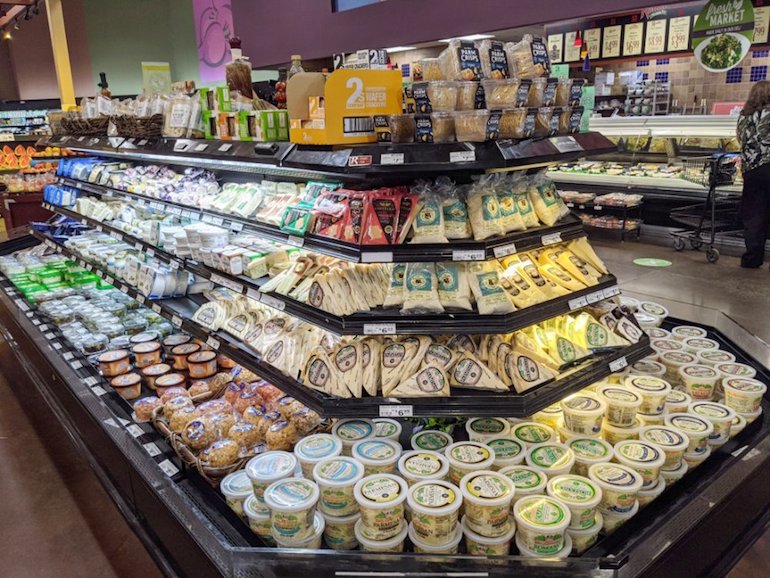Despite a dip from the COVID-fueled boom in 2020, independent supermarkets maintained elevated sales and profits in 2021 versus the pre-pandemic period, according to the 2022 Independent Grocers Financial Survey, a joint study by the National Grocers Association (NGA) and FMS Solutions.
Fifty-eight percent of independent grocers fell short of matching their 2020 same-store sales records, though many came close, as inflation provided a 6.5% lift in 2021, NGA said. Comparable-store sales declined 1.7% for the sector last year, following gains of 13.5% in 2020 — driven by consumer stockpiling after the onset of COVID-19 — and 2.5% in 2019.
“Supply chain challenges kept independent retailers on their toes with historically low order fill rates averaging 74.6%,” Robert Graybill, president and CEO of Fort Lauderdale, Fla.-based FMS Solutions, said in a statement. “This was compounded by labor shortages, a complex regulatory environment and going up against the biggest year in grocery retailing. In the tough marketplace, independents focused on implementing loyalty programs to optimize trips and spending, as reliance on the paper circular is dwindling.”
Ongoing strength in food-at-home dollar sales kept center-store sales strong in 2021, as those product categories accounted for almost 61% of independents’ business, the study found. NGA said shoppers continued to embrace home cooking essentials while searching for value. Varying levels of inflation and “rampant out-of-stocks” also shaped departmental contributions to the top line, the research showed.

Independent grocers have zeroed in on fresh foods, especially in the deli and produce departments, to help drive profit performance, according to the NGA/FMS study.
“Independent grocers focused on inventory management amid high inflation and kept turns high,” Graybill noted.
The 2022 Independent Grocers Financial Survey polled 374 independent supermarket operators representing nearly 2,000 stores on their financial and operational data for fiscal 2021, which ran through March 31, 2022. The survey will be explored in greater detail in a session at NGA’s Executive Conference and Public Policy Summit, which runs Oct. 24 to 26 in Washington, D.C.
“While down from the incredible spikes in 2020, independent grocers’ knowledge of the marketplace, grit and nimbleness resulted in the second-best year on record in terms of net profits before taxes,” Graybill observed.
Across the grocery industry in 2021, retailers were challenged to adapt to fluctuating supply and demand. Consumer spending and trips shifted between online and in-store shopping, as the indicidence of COVID rose and fell, while inflation and out-of-stocks pushed customers to switch between items, sizes, brands and stores, according to NGA.
In that environment, independents saw profit dip in 2021, and the pressure to manage inventory, inflation and demand squeezed margins in key departments, including meat and produce, the survey revealed. Total store margin decreased one percentage point to 27.4% in 2021, while expenses rose to 28.7% of sales, back to 2019 levels, with labor and benefits averaging 15% of sales. Many retailers also had to digest hikes utility costs.
“Slightly lower sales and compressed margins combined with rising expenses meant a year-over-year decrease in the net profit before taxes and EBITDA ratios,” Graybill explained. “However, this was to be expected in going up against profits that rose fivefold in 2020. At 3.62%, the net profit before taxes for independent operators in 2021 was the second-best result on record.”
That also was the case for EBITDA (earnings before interest, taxes depreciation and amortization), as the average EBITDA for independents came in at 5.66% for 2021.
“Navigating these volatile times is a tremendous accomplishment that will help independents through tough 2022 marketplace conditions,” NGA President and CEO Greg Ferrara stated.
NGA and FMS said that, each year, a group of retailers outperform the rest of the field by a wide margin in terms of profit. This top 25th percentile of independent grocers surveyed tallied an average net profit before taxes of 10.1%, improving on their 2020 performance with a sharper focus on fresh foods (namely in the produce and deli departments), higher margins, above-average transactions and bigger baskets. These “profit leaders” also were strong on the operational end, with a focus on shrink control and business reinvestment, the research showed.
“A review of their traits shows a relentless focus on efficiency and effectiveness,” Graybill commented.
Amid a turbulent economic climate in 2022, independent grocers will need to continue to hone their business strategies to address elevated inflation, higher costs of doing business, volume and unit declines, and prolonged marketplace volatility, according to NGA.
“For many years, independent grocers have proven to be resilient, creative and nimble,” Ferrara added. “Strongly rooted in their communities, independents are well-positioned to weather the perfect storm of supply-chain, inflation and labor challenges.”


